Seeing Americans have Thanksgiving holidays, Alanruo [1] tries to search for similar festival in Taiwan and finds a similar counterpart, the Well-beings sacrifice:
每年農曆十月十五前後,台灣的許多庄頭都會舉行歲末的平安祭,俗稱謝平安或拜平安。拜平安的對象是天公,謝天公其實就是表達對過去一年所有事業家庭進步的感謝,我認為這實實在在就是台灣的感恩節。
Below are some photos that show how the Taiwanese-version Thanksgiving looks like.
In some villages, people would jointly organize a three to seven day long Well-beings sacrifice to express their thanks to the deities and spirits who had protected them from ill-luck in the past year. Below is a picture showing the beautiful altar set up for the Taoist priests to perform a ritual.

Photo courtesy of alhorn [2]
This Well-beings sacrifice is not only for deities but also for ghosts, and the bamboo poles with flags in the following picture are erected several days before the ritual to catch the spirits’ attention for the ceremony.

Photo courtesy of Alanruo [3]
Alanruo [3] explained the ritualistic function of the grass inside the bucket:
也不能忘記給甲兵秣馬用的草料

Photo courtesy of Alanruo [3]
Big pigs are presented as sacrifices.

Photo courtesy of alhorn [2]
There is “real” food for deities, ghosts, and humans, and there is “symbolic” food for deities and ghosts.

Photo courtesy of Alanruo [1]
Time has changed and so do items presented in the ceremony. The tradition keeps renovating–Alanruo [3] discovered some new offer items:
糖果屋有什麼了不起,王子麵屋也很酷

Photo courtesy of Alanruo [3]
Because there are so much food and so many ghosts, it is important to have Master Dashi (Dashihye, 大士爺) [4], an underworld deity, standing by the tables to make sure that food for the ghosts is evenly distributed.

Photo courtesy of alhorn [5]
In the evenings, there are troupe performance or movie show to entertain spirits and human. At the end of the Well-beings sacrifice, the taoist priests would thank gods again and give blessing to the guests.